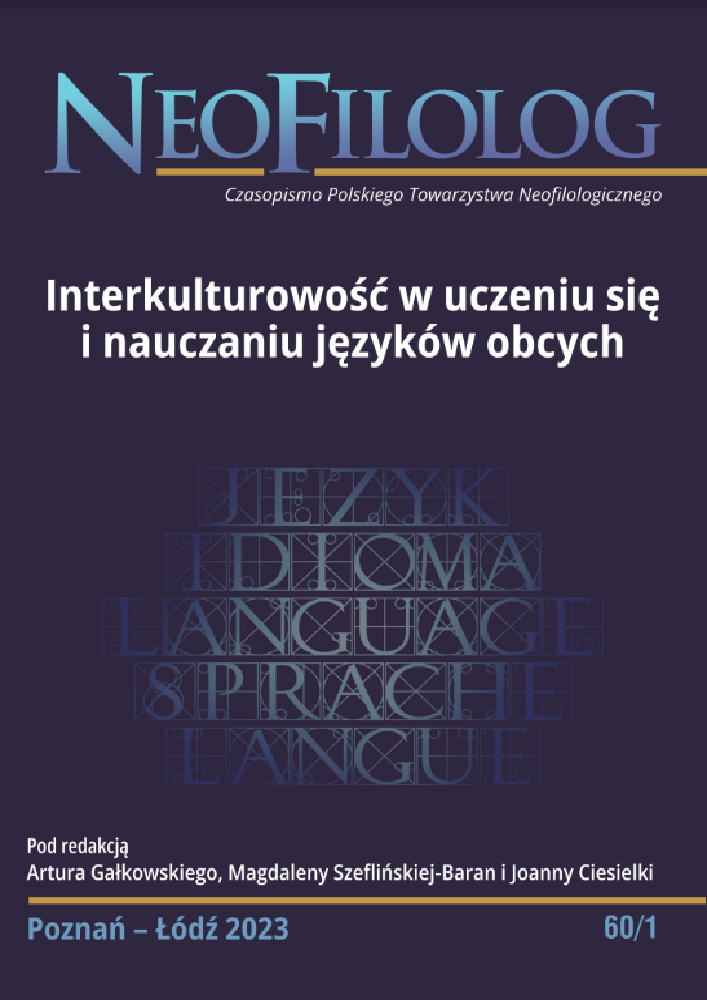Abstract
Meals are commonly known to be a crucial element of life, culture and interpersonal relationships in the Italian Peninsula. In Italian dictionaries of phraseology, idiomatic expressions representing names of culinary items are the vast majority of dictionary items. This is a sign of the importance of meals, also considered as feasting together and the Italian food centrism. As the cultural component is an integral element of language education at an academic level, Italian culinary items as components of idiomatic and fixed expressions in Vatican culinary items related to culturally rooted habits and secular Catholic rituals will be analyzed. The study presented in the paper aims at: 1. clarifying the sociolect specifics of the Vatican’s clergy and kitchen staff members; 2. determining the importance of food in the socio-cultural reality in the Vatican as a type of a culture code and an element of the regional/national culture; 3. emphasizing the essence of semantic and lexical problems related to food in academic intercultural didactics, e.g. a specialization proseminar in linguistics or translation studies or a university instructor’s own thematic seminar on culinary matters in the Italian Peninsula.
References
Apresjan J. (1980), Semantyka leksykalna. Synonimiczne środki języka. Wrocław–Warszawa–Kraków: Ossolineum.
Artusi P. (2017), Włoska sztuka dobrego gotowania. Warszawa: Muza S.A.
Bańczerowski J., Pogonowski J., Zgółka T. (1982), Wstęp do językoznawstwa. Poznań: Wydawnictwo Naukowe UAM.
Celada E. (2010), Sekrety kuchni Watykanu. Warszawa: Świat Książki.
Chruszczewski P. P., Kudła M. (2016), Etnonimy pokarmosemiczne. Tradycje kulinarne w nazwach grup etnicznych z perspektywy językoznawstwa antropologicznego, (w:) Wach S., Buczek K., Knapik A.R., Chruszczewski P. P. (red.), Język, kultura, komunikacja. Wrocław: PAN, s. 9–22.
Drzymała P. (1993), Fraseologia italiana. Słowniczek frazeologiczny włosko-polski. Poznań: Wydawnictwo Naukowe UAM.
Europejski System Opisu Kształcenia Językowego (2003). Online: https://www.ore.edu.pl/wp-content/uploads/attachments/ESOKJ_Europejski-System-Opisu.pdf [DW 10.01.2023].
Frosini G., Montanari M. (2012), Il sapore di una nazione, (w:) Frosini G., Montanari M. (red.), Il secolo artusiano. Atti del Convegno Firenze-Forlimpopoli 30 marzo - 2 aprile 2011. Firenze: Accademia della Crusca, s. 15-20.
Galisson R. (1987), Accéder à la culture partagée par l`entremise des mots à C.C.P. (Charge Culturelle Partagée). „Études de Linguistique Appliquée”, nr 67, s. 119-140.
Godzich A. (2023), Językowo-kulturowy obraz pożywienia człowieka w języku włoskim - implikacje glottodydaktyczne, (w:) Szczęk J., Pawlikowska-Asendrych E. (red.), Kulinarische Welt in Sprache, Kultur und Literatur, Bd. II. Hamburg: Verlag Dr. Kovac, s. 283-295.
Hall E.T. (1976), Beyond Culture. Nowy Jork: Doubleday.
Lapucci C. (1993), Il dizionario dei modi di dire della lingua italiana. Mediolan: Garzanti.
Meisels W. (2001), Podręczny słownik włosko-polski. Dizionario pratico italiano-polacco. M-Z. Warszawa: Wiedza Powszechna.
Moyer-Nocci K., Rolandi G. (2019), The Eternal Table: A Cultural History of Food in Rome. Lanham (Maryland): Rowman & Littlefield Publishers.
Nagórko A., Łaziński M., Burkhardt H. (2004), Dystynktywny słownik synonimów. Kraków: Universitas.
Peeters B. (2016), APPLIED ETHNOLINGUISTICS is cultural linguistics, but is it CULTURAL LINGUISTICS? „International Journal of Language and Culture”, nr 3/2, s. 137–160. DOI: https://doi.org/10.1075/ijolc.3.2.01pee
Pittàno G. (1992), Frase fatta capo ha. Dizionario dei modi di dire, proverbi e locuzioni. Bolonia: Zanichelli.
Sapir E. (1978), Kultura, język, osobowość. Wybrane eseje. Warszawa: PIW.
Tabakowska E. (1999), Gramatyka i obrazowanie. Kraków: PAN.
Turasiewcz, M., Kieżun, B. (2022), Farina. Kuchnia śródziemnomorska. Kraków: ZNAK.
Wierzbicka A. (1996), Prototypes and invariants, (w:) Wierzbicka A., Semantics. Primes and universals. Oxford i Nowy Jork: Oxford University Press, s. 148-169.
Wierzbicka A. (2019), Słowa klucze. Różne języki – różne kultury. Warszawa: Wydawnictwo Uniwersytetu Warszawskiego. DOI: https://doi.org/10.31338/uw.9788323539193
Wilkoń A. (2000), Typologia odmian współczesnej polszczyzny. Katowice: Wydawnictwo Uniwersytetu Śląskiego.
License
Copyright (c) 2023 Anna Godzich, Szymon Machowski

This work is licensed under a Creative Commons Attribution-NoDerivatives 4.0 International License.
Authors
Authors of texts accepted for publication in Neofilolog are required to complete, sign and return to the Editorial team’s office the Agreement for granting a royalty-free license to works with a commitment to grant a CC sub-license.
Under the agreement, the authors of the texts published in Neofilolog grant Adam Mickiewicz University in Poznań a non-exclusive, royalty-free license and authorize the use of Attribution-NoDerivatives 4.0 International (CC BY-ND 4.0) Creative Commons sub-license.
The authors retain the right to the free disposal of the work.
Users
Interested Internet users are entitled to use works that have been published in Neofilolog since 2017, under the following conditions:
▪ attribution – obligation to provide, together with the distributed work, information about the authorship, title, source (link to the original work, DOI) and the license itself.
▪ no derivatives – the work must be preserved in its original form. Without the author's consent, it is not possible to distribute the modified work in the form of translations, publications, etc.
Copyrights are reserved for all texts published since 2017.
Miscellaneous
Adam Mickiewicz University in Poznań retains the property right as a whole (layout, graphic form, title, cover design, logo etc.).

